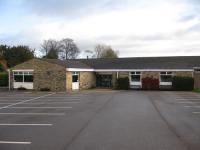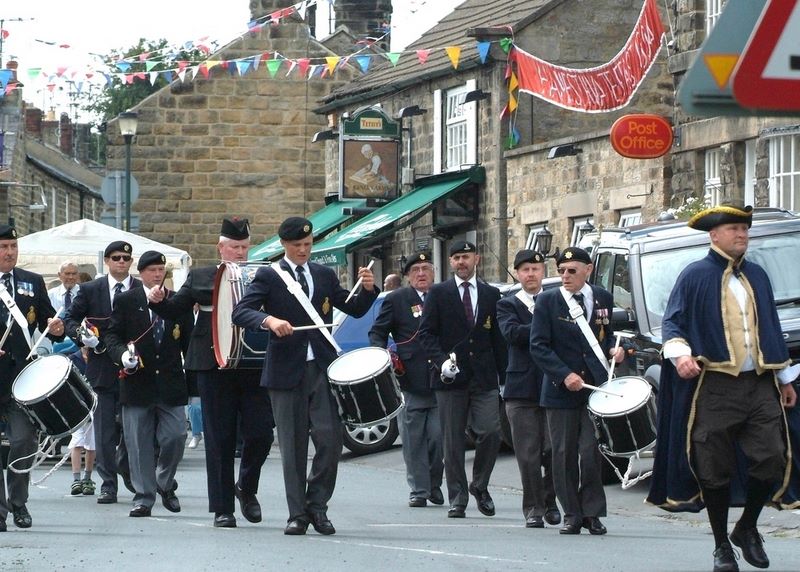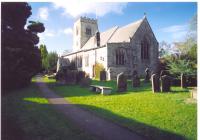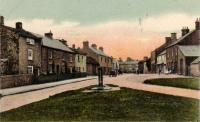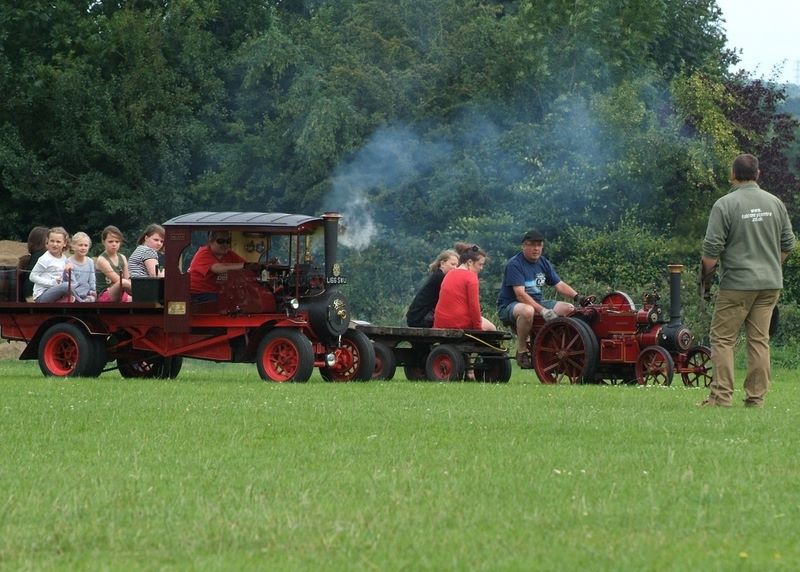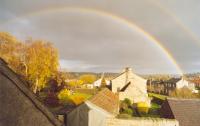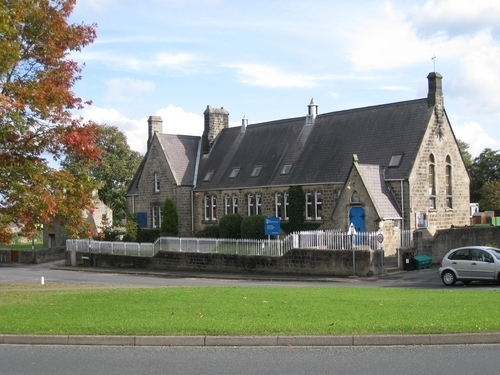Recent articles
© DT Online 2010 - 2025
| Amy's HampsthwaiteA History Walking Tour to explore aspects of the village in 1913 - the date of her step-son Eric's death at The Laurels. . . . . . . . but where is or was The Laurels and why did Eric's life end in Hampsthwaite? Click on images to open full-size in new window and use the Browser back arrow to return to here. Return to Amy Woodforde-Finden
CONTENT Farleigh House | Methodist Church | Pump Cottage | Finden Gardens | Village Room | Peckfield Cottages | High Street | Joiners Arms | Old Post Office | Greenside House and Laurel Cottage | The Old Parsonage | Hampsthwaite C.E. Primary School | Saddlers Cottage | Thimbleby House | Lamb Inn | St Thomas a'Becket | Woodforde-Finden Memorial | Amy Woodforde-Finden Monument Use the Browser back arrow to return to here [AKA Hollins Farm House AKA The Laurels (site of)] sits on the corner of Hollins Lane as it enters Hampsthwaite from the east. It is believed to be a rebuild and extension to some of the original ‘The Laurels’ Farm which can be seen on the OS Yorkshire Sheet CLIII.NE Revised:1907, Published:1910 The current owner recalls that there used to be a line of Laurels along the roadside edge.
This location known locally as ‘Annakins Corner’ . Church Register shows that George and Eleanor Annakin also Eva Florence Barker Houseman (nee Annakin) all died while living at ‘The Laurels’. [A History of Hampsthwaite, Book 4, Village Buildings on the Eve of the Great War].. The Chelmsford Chronicle, 13th September 1901 reported: “May 1900. Mr Eric Woodforde-Finden has just arrived in England invalided. His horse was shot under him in action, and he came down a bad fall, breaking his jaw and arm, and injuring his chest” and the 1911 Census shows him living in Seckington Rectory in Tamworth. DROWNED IN HIS FOOT-BATH Mr. Finden, who was of independent means, lived at The Laurels, Hampsthwaite, and on Tuesday morning, when the servant knocked at his door, no answer was received. Mr. Finden was found on the bedroom floor with his head in his foot-bath, in which there was about a gallon of water. He was dead. He had been treated by Dr. John Ashby, Ripley, for fits. THE LAURELS FARM So, is it really credible that Eric Woodforde-Finden, of independent means and from a wealthy family, would have had rooms and servant's accommodation in a building as described above . . . . or did he stay at Hollins Hall, further on beyond The Laurels, and the Coroner was misinformed? HAMPSTHWAITE METHODIST CHURCH PUMP COTTAGE The name Pump Cottage clearly arises from its proximity to the water pump lying close by (in the field behind Clarence Terrace) and one of Hampsthwaite’s few places where water could be drawn before the arrival of piped mains water. The Land Tax survey of 1910 describes this property as including a lock up butchers shop fronting Hollins Road and with a slaughter house which is believed to have become the bungalow now standing close to the south of the cottage. The census of 1911 shows the occupants of the cottage to have been George Annakin aged 37, a stone mason and his wife Eleanor (nee Barker) aged 38, and their daughter Eva who seems later to have married into another long-established Hampsthwaite family viz: the Housemans. FINDEN GARDENS VILLAGE ROOM Some fifty metres up the High Street from its junction with Hollins Lane is the Villlage Room. The Village Room began its life as a purpose-built reading room created by Letitia Wright of Hollins Hall, the widow of John Field Wright, for the purpose of creating a memorial to her late husband. PECKFIELD COTTAGES Across the High Street from the Village Room is Peckfield Close, where there used to be old thatched cottages fronting on to the High Street. They had to be pulled down when the council houses were about to be built. The land on which Peckfield Close stands, once formed part of Manor Farm, owned by the Tang Estate who sold it in 1948 to Nidderdale Rural District Council. The estate is assumed to commemorate Hampsthwaite’s former Vicar, the Reverend Herbert John Peck who served the local community for some fifty years and died in 1949. HIGH STREET Moving back towards the village centre, on the left is Mally's Cottage, probably mid-late C18 and said to have been a drovers' shelter. The High Street forms part of a Roman Road which led from Ilkley to Aldborough. This was too far for a Legion to march in a day and Hampsthwaite is both approximatelty half way and on the side of the River Nidd which was crossed some 200 metres downstream from Hampsthwaite Bridge. There is therefore a high probability of a Roman settement here - but yet to be found! THE JOINERS ARMS Licensing records of 1777 reveal there were 3 public houses existing in the village which appear to be the Bay Horse Inn at Swincliffe, the Lamb Inn in Church Lane and the Joiner's Arms. How early those houses were established cannot be precisely stated but it may be assumed that the Joiner's Arms has a long history. The Inclosure Map for the 1770s appears to show a building on the site and the house certainly figures on the first O.S map of 1853. THE OLD POST OFFICE Looking across to Hollins Lane at its junction with High Street, it is hard to imagine that this was once the site of Hampsthwaite's Post Office! An earlier photograph reveals the shop and post office which stood here until it was demolished in the 1930s to allow the road to be widened to accommodate modern traffic. The 1901 Census lists William Wilson as Grocer and Postmaster, together with Clara M Stockdale as Assistant Postmaster. Clara Stockdale seems to have married a Mr Moon after 1901 as seen on the name-board in photograph. GREENSIDE HOUSE AND LAUREL COTTAGE Census Returns show that from 1871 Greenside House (formerly Rose Villa) was occupied by Dr. Richard S. Veale a 'General Practitioner' and an internal door connected it to adjoining Laurel Cottage, a Grade II Listed Building dated 1764, which was the Surgery. The Veale family had by 1881 removed to Harrogate. During the decade they had lived in Hampsthwaite six children were born, one of whom, Laura Sobey Veale (1867-1963), later became the first Yorkshire woman to become a doctor. But by 1891 it was no longer occupied by a doctor. The last 'General Practitioner', Dr Saunders had moved to Bilton Garth (now Thimbleby House) in Church Lane and is shown at that new address in the census return for 1891. VILLAGE PUMP Until the arrival of a piped water supply, villagers were obliged to get their water from a stream or a pump and several pumps can be seen marked on early maps. "Our house backed onto the Cockhill Beck and every so far along there were steps down to the water. This was where everyone had to come to collect a supply for clothes-washing and other domestic chores. Drinking water came from the three pumps in the village - one at the top of the High Street, one on the Village Green, one down in the "church farmyard". "After lunch at school and before afternoon lessons, we went to fetch water from the well or from one of the three pumps: there was one on the Green, one in the yard where Mr. Horner lives and one at the top of the village. I caught typhoid from that one". This cutting from the local newspaper of 1932 shows the pump in use before the arrival of a main water supply in the village, probably in the 1930s. THE OLD PARSONAGE The 1901 Census lists Canon Herbert J Peck wth his wife as occupants, together with their daughter Geraldine E. Peck who was 2 years old at this time therefore 22 years old when she sang at the unveiling of the Amy Woodforde-Finden's Monument in 1923. A church inventory of 1743 lists the Vicarage House and in 1910 it was described by the Land Tax valuation documents as "Stone and slate rough cast house, rather old, condition fairly good". It is now a Grade II listed property described as . . . "House. Mid-late C18 with early/mid C19 remodelling and extension and restoration c1980 . . ." Until its disposal by the church authorities in the 1970s (when a new Vicarage was built in its grounds) this was the residence of the Vicars of Hampsthwaite HAMPSTHWAITE C.E. PRIMARY SCHOOL William Grainge writing in 1871 ("Harrogate and the Forest of Knaresborough") tells us . . . . "The" national school was built by public subscription, in 1861. It is an elegant and substantial building of stone, in the Elizabethan style of architecture; comprising schoolroom, with classroom, and master's house attached. In order to make this establishment of permanent benefit to the parish, the late Bilton Josephus Wilson endowed it with the interest of £1,500, on the 25th January, 1865. . . " The Conservation Area document says Hampsthwaite C.E. Primary School . . . ."is typical of its era with tall high-level windows and a steeply pitched roof. Its gabled porch echoes that of the Church and the railings are a dominant feature of the village green". SADDLERS COTTAGE Across the Green next to the school, the appearance of Saddlers Cotttage suggests an age going back well into the 18th century. It is the sole survivor of a terrace shown on the O.S.1853 map and which were the home of the Thackeray family, including the great-grandfather of William Makepeace Thackeray, the author of "Vanity Fair". The name of the cottage reflects its later occupation by (amongst others) William "Saddler" Haxby who lived at Ashville and worked here. THIMBLEBY HOUSE The date-stone of 1755 built into Thimbleby House suggests the property is one of the oldest in Church Lane and probably contemporary with The Lamb Inn on the opposite side of the road. The 1901 and 1911 Census returns show it to be the home of Dr John Ashby, a surgeon from Hackney. John Ashby died November 12th 1913 but is known to have been practising in 1912 and who, as reported in the Leeds Mercury, was treating Eric Woodforde-Finden for fits. LAMB INN The three properties opposite the church at the bottom of Church Lane are: "The End Cottage", "Lamb Cottage" and "Cornerstone House". They once formed part of a single property known as "The Lamb Inn", a licensed inn dating back as least as far as the start of the 19th Century but deemed to be one of three ale-houses in Hampsthwaite being granted licences by Magistrates at Knaresborough as early as 1771. Harry Speight, in his book "Nidderdale and the garden of the Nidd" published in 1894, mentions that the premises were turned into a temperance hotel in 1889. Annie Pawson, (1901-1991) who had spent all but a handful of her 83 years in Hampsthwaite, said in a Yorkshire Post article some years ago "The funeral tea after the service was always held at the Temperance Hotel. The lady there would ask the mourners in advance whether they wanted it with ham or potted meat sandwiches". The Pateley Bridge and Nidderdale Herald of Saturday October 24th 1863, added that the Lamb Inn was used also for Inquests - and would have been at the time of Eric's death in 1913. St. THOMAS a'BECKET Passing through the Lych Gate note the carved mouse atop the small gate showing this to be the work of Robert Thompson of Kilburn. During rebuilding of the Parish Church in 1901 a number of stone grave covers were discovered beneath the foundations. These were identified as Saxon or early Norman in design and workmanship, and have been preserved, several of them being set in the walls of the porch. The tower dates back to pre-Reformation times. On the night of 29th December, 1170, four knights murdered Thomas Becket. The four knights to escaped to Knaresborough, and later to Rome, where the Pope pardoned them on condition they did penance. It is believed that part of Hugh de Morville's penance was the building of a church - dedicated to St. Thomas a Becket at Hampsthwaite. Hampsthwaite Church was probably destroyed in the period 1318-19 and then rebuilt sometime between the middle of the 14th and the beginning of the 15th centuries then again in 1820 before its current restoration in 1901 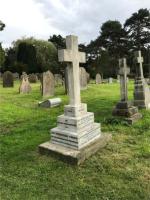 WOODFORDE-FINDEN MEMORIAL The Inscriptions read as follows: 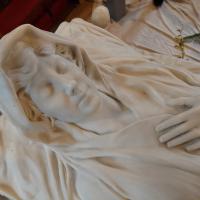 AMY WOODFORDE-FINDEN MONUMENT The memorial was created by George Edward Wade, a well-known sculptor who also created monuments to Queen Victoria, King Edward VII, King George V, Queen Alexandra of Denmark and Queen Mary of Teck, and the founders of the Salvation Army, William and Catherine Booth. When the memorial was unveiled in 1923, the vicar’s daughter, Miss Peck, sang her song “White Sentinels”. The vicar at the time was Reverend Herbert John Peck (1868-1949) and Geraldine Edith Peck (1898-1971), became an Associate of the Royal College of Music. The Harrogate Royal Hall orchestra, conducted by Howard Carr, also performed “Till I awake” from the “Indian Love Lyrics”, “L’Envoir” from “The Myrtles of Damascus” and “Allah be with us” from “A Lover in Damascus” at the unveiling, and John Hill of Bradford sang two sacred solos. Amy's Hampsthwaite A History Walking Tour to explore aspects of the village in 1913 - the date of her step-son Eric's death at The Laurels. . . . . . . . but where is or was The Laurels and why did Eric's life end in Hampsthwaite? Click on images to open full-size in new window and use the Browser back arrow to return to here. Return to Amy Woodforde-Finden |

























